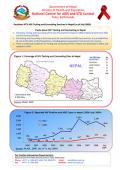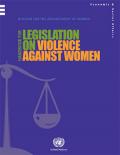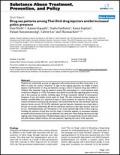What's New
Displaying results 4171 - 4180 of 4914

Resource | Fact Sheets,
Facts about HIV Testing and Counseling in Nepal
- Voluntary Testing and Counseling of HIV was first started in Nepal in 1995 at National Centre for AIDS and STDC ontrol (NCASC).
- HIV Testing and Counseling is the entry point for overall HIV and AIDS case services. It is provided free of cost to the Most at Risk Populations, including general population from all over the country.
- There is a National Guidelines for Testing and Counseling of HIV in Nepal, first developed in 2003, and updated in 2007.

Resource | Publications,
This Southeast Asian multi-country study on HIV vulnerability of sex trafficked girls and women is the first of such systematic research ever undertaken in the Southeast Asia region. The findings and lessons from the study including limitations and need for more investigations can provide us with powerful evidence and impetus to further explore this unexplored field. In this context, the study has taken us a step closer towards more comprehensive and integrated approach to prevent human trafficking and HIV infection in the region.

Resource | Publications,
The world is responding. We see a growing global momentum to stop violence against women. In 2008, the Secretary-General launched a multi-year global campaign called UNiTE to End Violence against Women. He is appealing to all partners to join forces to eliminate this scourge. The Campaign recognizes the power of the law: one of its five key goals is for all countries to adopt and enforce, by 2015, national laws that address and punish all forms of such violence, in line with international human rights standards.
This Handbook for Legislation on Violence against Women, prepared by the Department of Economic and Social Affairs/Division for the Advancement of Women (DESA/DAW), is intended to assist States and other stakeholders to enhance existing, or develop new laws to protect women.
The recommendations it provides in the model framework for legislation on violence against women serve as a useful tool in supporting efforts to provide justice, support, protection and remedies to victims and to hold perpetrators accountable. The commentaries which accompany the recommendations highlight promising examples from laws worldwide.

Resource | Publications,
Sexual risk and STDs are relatively high among injecting drug users (IDUs) in Vietnam. We sought to determine characteristics of sexually active IDUs and correlates of high-risk sexual practices among IDUs in Bac Ninh province in northern Vietnam.
IDUs who inject socially and IDUs who share needles are likely to engage in highrisk sexual behaviors and may serve as an important bridge group for epidemic HIV transmission in Vietnam. In addition to messages regarding the dangers of sharing needles and other injection equipment, preventive interventions among newly initiated IDUs should also focus on reducing sexual risk.

Resource | Publications,
The present study describes complex drug and sexual risk in a group of male sex workers who were recruited in the context of a larger study of young heroin users in Hanoi, Vietnam. Male sex workers were significantly more likely than male non-sex workers to be migrants and to have unstable housing, to have lifetime exposure to marijuana, 3,4 methylenedioxymethamphetamine (MDMA, ecstasy), amphetamines, cocaine and morphine. Male sex workers are more likely to currently use MDMA, amphetamines, morphine and to 'smoke' as their most frequent mode of heroin administration. Male sex workers are more likely to have both male and female concurrent sex partners, to have a history of sexual victimisation, to have had more than three different sex partners in the past 30 days, and to have had partners who injected drugs before sex or who used drugs during sex. In their last sexual encounter with a client partner, approximately one-third (31.1%) reported having had receptive anal sex. In nearly three-quarters of these exchanges (71.4%), no condom was used. Similarly, in their last sexual encounter with a client partner, 42.2% reported having had insertive anal sex and in nearly half (47.4%) of these encounters no condom was used. Consistent with recent data from elsewhere in the region, there is an urgent need for additional research on male sex work in South-east Asia in order to properly situate behavioural interventions for male sex workers in this region.

Resource | Publications,
Thailand has traditionally pursued an aggressive enforcement-based anti-illicit drug policy in an effort to make the country "drug-free." In light of this ongoing approach, we sought to assess impacts of enforcement on drug use behaviors among a cohort of injection drug users (IDU) in Thailand. We examined drug use patterns among IDU participating in a cross-sectional study conducted in Bangkok (n = 252). Participants were asked to provide data regarding patterns of drug use in the previous six months, including types of drugs consumed, method of consumption, frequency of use, and weekly income spent on drugs.
We also conducted bivariate analyses to identify a possible effect of a reported increase in police presence on measures of drug use and related risk behaviors among study participants. One hundred fifty-five (61.5%) individuals reported injection heroin use and 132 (52.4%) individuals reported injection midazolam use at least daily in the past six months. Additionally, 86 (34.1%) individuals reported at least daily injection Yaba and Ice (i.e., methamphetamine) use. Participants in our study reported high levels of illicit drug use, including the injection of both illicit and licit drugs. In bivariate analyses, no association between increased police presence and drug use behaviors was observed. These findings demonstrate high ongoing rates of drug injecting in Thailand despite reports of increased levels of strict enforcement and enforcement-related violence, and raise questions regarding the merits of this approach.

Resource | Presentations,
The study is targeted at the strategic decision-making level:
- Are current responses effective and cost-effective?
- What is the scale-up perspective?
- Priority Setting of Injecting Drug User (IDU) interventions in Asia

Resource | Publications,
Afghanistan is widely known and appreciated for its rich history, culture, literature and arts as well as its magnificent landscape. It is also widely known that large numbers of Afghans die, or live wretched lives, because violence is an everyday fact of life. Such violence is not openly condoned but neither is it challenged nor condemned by society at large or by state institutions. It is primarily human rights activists that make an issue of violence including, in particular, its impact on, and ramifications for, women and girls in Afghanistan.
The report seeks to put back on the agenda some of the issues pertaining to the enjoyment of all human rights by all Afghan women that are being increasingly ignored. The problems identified in this report require further discussion and public debate, with a view to informing appropriate legal, policy and awareness-raising measures.

Resource | Publications,
HIV second generation surveillance is a system of surveillance that conducts repeated surveys of both behaviors, HIV serology and prevalence of STI (which serves as a proximate measure for recent exposure to unprotected sex) among population most at risk of HIV infection.
In 2008, the third round of HIV surveillance was needed in Lao PDR to investigate the state of the epidemic, estimate the impact of the program implemented since last round and adjust interventions accordingly.

Resource | Reviews and Snapshots,
The HIV/AIDS situation in Cambodia can be described as improving but fragile, with the estimated prevalence rate slowly declining, remaining consistently below one percent for the last three years.
This report includes the results of the second National AIDS Spending Assessment (NASA II) in Cambodia, covering the fiscal years 2007 and 2008. NASA II was carried out from December 2008 to January 2009 under the leadership of the National AIDS Authority (NAA). It was designed to build in a coherent manner on NASA I which was carried out at the end of 2007 and covered the year 2006.





